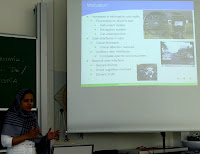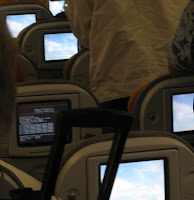 Our group was involved in 3 papers that are published at Pervasive 2009 in Nara.
Our group was involved in 3 papers that are published at Pervasive 2009 in Nara.
The first contribution is a study on public display that was presented by Jörg Müller from Münster. The paper explores display blindness that can be observed in the real world (similarly to banner blindness) and concludes that the extent to which people look at displays is very much correlated to the users expectation of the content of a display in a certain location [1].
 The second short paper is a survey on car advertising and has been conducted in the context of the master thesis of Christoph Evers. The central question is about the design space of dynamic advertising on cars and how the users perceive such a technology [2].
The second short paper is a survey on car advertising and has been conducted in the context of the master thesis of Christoph Evers. The central question is about the design space of dynamic advertising on cars and how the users perceive such a technology [2].
 Dagmar presented a paper on vibra-tactile output integrated in the steering wheel for navigation systems in cars. The studies explored how multi-modal presentation of information impact driving performance and what modalities are preferred by users. The general conclusion is that combining visual information with vibra-tactile output is the best option and that people prefer multi-modal output over a single modality [3].
Dagmar presented a paper on vibra-tactile output integrated in the steering wheel for navigation systems in cars. The studies explored how multi-modal presentation of information impact driving performance and what modalities are preferred by users. The general conclusion is that combining visual information with vibra-tactile output is the best option and that people prefer multi-modal output over a single modality [3].
[1] Jörg Müller, Dennis Wilmsmann, Juliane Exeler, Markus Buzeck, Albrecht Schmidt, Tim Jay, Antonio Krüger. Display Blindness: The Effect of Expectations on Attention towards Digital Signage. 7th International Conference on Pervasive Computing 2009. Nara, Japan. Springer LNCS 5538, pp 1-8.
http://www.springerlink.com/content/gk307213786207g2
[2] Florian Alt, Christoph Evers, Albrecht Schmidt. User’s view on Context-Aware Car Advertisement. 7th International Conference on Pervasive Computing 2009. Nara, Japan. Springer LNCS 5538, pp 9-16.
http://www.springerlink.com/content/81q8818683315523
[3] Dagmar Kern, Paul Marshall, Eva Hornecker, Yvonne Rogers, Albrecht Schmidt. Enhancing Navigation Information with tactile Output Embedded into the Steering Wheel. 7th International Conference on Pervasive Computing 2009. Nara, Japan. Springer LNCS 5538, pp 42-58.
http://www.springerlink.com/content/x13j7547p8303113





